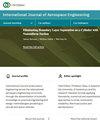多频GNSS信号分析及改进的中长基线单历元RTK方法
IF 1.2
4区 工程技术
Q3 ENGINEERING, AEROSPACE
引用次数: 0
摘要
近年来,由于多卫星系统的跨越式发展,可见卫星的数量显著增加。北斗卫星导航系统(BDS)和伽利略卫星导航系统(Galileo)向用户广播三频及以上信号,增强了单历元实时运动学定位的可靠性、连续性和可用性。本文成功地开发了一种改进的单历元多频多系统RTK方法。首先,以较高的成功率固定了Galileo和BDS的超宽车道(extra-wide lane, EWL)歧义,并通过变换过程实现了Galileo和BDS的宽车道(wide lane, WL)歧义。其次,利用Galileo和BDS的固定WL模糊度,提高GPS WL模糊度的固定率;第三,提出了电离层延迟参数化策略,以提高GPS的窄道模糊固定率。并利用实时数据验证了本研究方法的可行性。实验结果表明,全工作能力(FOC) E5a/E5b在各频率下的载波噪声密度比(C/N0)最佳,IIR-M L1次之,IIR-A/B L2表现最差。一般情况下,伽利略信号的多径组合(MPC)在0.4 m范围内显示均方根(RMS)值,排序如下:e1 >E >E 5a。对于北斗二号系统,B3信号表现最佳,B1信号表现最差。GPS L1信号的MPC误差的均方根值小于L2信号。此外,在50 km基线下,使用无电离层(IF)组合的GPS NL模糊固定率在比值阈值为2时仅为47.74%。最后,与无电离层组合方法相比,该方法的GPS NL模糊固定率提高了45.52%。提出的方法拓宽了变形监测在中长期基线情景下的未来应用。本文章由计算机程序翻译,如有差异,请以英文原文为准。
Analysis of Multifrequency GNSS Signals and an Improved Single-Epoch RTK Method for Medium-Long Baseline
In recent years, the quantity of visible satellites has increased significantly due to multiple satellite systems that leaped forward. The BeiDou Navigation Satellite System (BDS) and Galileo satellite navigation system (Galileo) broadcast triple-frequency signals and above to users, thus enhancing the reliability, continuity, and availability of the single-epoch real-time kinematic (RTK) positioning. In this study, an improved single-epoch multifrequency multisystem RTK method is successfully developed for the medium-long baseline. First, the Galileo and BDS extra-wide-lane (EWL) ambiguities are fixed at a high success rate, and the Galileo and BDS wide-lane (WL) ambiguity is achieved via the transformation process. Second, the fixed WL ambiguities of Galileo and BDS are exploited to elevate the fixed rate of GPS WL ambiguity. Third, the parametric strategies for ionospheric delay are carried out to upregulate the narrow-lane (NL) ambiguity-fixed rate of GPS. Further, the real-time data are adopted for verifying the feasibility of the method developed in this study. The experimental results demonstrate the optimal carrier-to-noise density ratio (C/N0) of full operational capability (FOC) E5a/E5b at all frequencies, followed by IIR-M L1, and IIR-A/B L2 exhibits the worst performance. Generally, the multipath combination (MPC) of Galileo signals shows root mean square (RMS) values within 0.4 m, ordered as follows: . For the BDS-2, the B3 signal exhibits optimal performance, while the B1 signal is the worst. The RMS of MPC errors of L1 signals is smaller than the L2 signals for the GPS. Furthermore, under the 50 km baseline, the GPS NL ambiguity-fixed rate using the ionosphere-free (IF) combination reaches only 47.74% at the ratio threshold of 2. Finally, compared to the ionosphere-free combination method, the GPS NL ambiguity-fixed rate is increased by 45.52% with the presented method. The proposed approach broadens the future application of deformation monitoring in medium-long baseline scenarios.
求助全文
通过发布文献求助,成功后即可免费获取论文全文。
去求助
来源期刊

International Journal of Aerospace Engineering
ENGINEERING, AEROSPACE-
CiteScore
2.70
自引率
7.10%
发文量
195
审稿时长
22 weeks
期刊介绍:
International Journal of Aerospace Engineering aims to serve the international aerospace engineering community through dissemination of scientific knowledge on practical engineering and design methodologies pertaining to aircraft and space vehicles.
Original unpublished manuscripts are solicited on all areas of aerospace engineering including but not limited to:
-Mechanics of materials and structures-
Aerodynamics and fluid mechanics-
Dynamics and control-
Aeroacoustics-
Aeroelasticity-
Propulsion and combustion-
Avionics and systems-
Flight simulation and mechanics-
Unmanned air vehicles (UAVs).
Review articles on any of the above topics are also welcome.
 求助内容:
求助内容: 应助结果提醒方式:
应助结果提醒方式:


